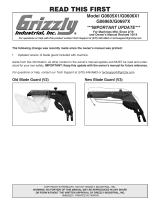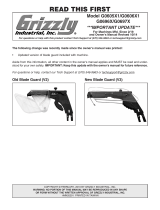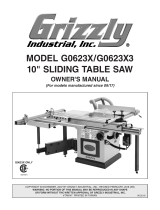
Table Of Contents
SECTION 1: SAFETY ....................................................................................................................... 2
Safety Instructions for Power Tools ........................................................................................... 2
Additional Safety Instructions for Rip Saws ............................................................................... 4
SECTION 2: INTRODUCTION ......................................................................................................... 5
Commentary ............................................................................................................................... 5
SECTION 3: CIRCUIT REQUIREMENTS ........................................................................................ 6
Voltage & Amperage Draw ........................................................................................................ 6
Circuit Breaker ........................................................................................................................... 6
Connection Type ........................................................................................................................ 6
Circuit Capacity .......................................................................................................................... 6
Minimum Cord Size .................................................................................................................... 7
Grounding ................................................................................................................................... 7
Extension Cords ......................................................................................................................... 7
Rewire To 440V (3-Phase) ....................................................................................................... 8
SECTION 4: FEATURES & CONTROLS ......................................................................................... 9
External Features ....................................................................................................................... 9
Control Panel ........................................................................................................................... 10
SECTION 5: SET UP ...................................................................................................................... 11
About this Section .................................................................................................................... 11
Unpacking ................................................................................................................................ 11
Loose Parts Inventory .............................................................................................................. 12
Hardware Recognition Chart .................................................................................................... 14
Site Considerations .................................................................................................................. 15
Clean Up .................................................................................................................................. 15
Power Cord .............................................................................................................................. 16
Placement ................................................................................................................................ 16
Test Run ................................................................................................................................... 17
Remove The Blade .................................................................................................................. 17
Scale Calibration ...................................................................................................................... 18
Dust Collection ......................................................................................................................... 19
Auxiliary Rollers ....................................................................................................................... 19
SECTION 6: OPERATIONS ........................................................................................................... 21
Safe Operation ......................................................................................................................... 21
Adjusting Feed Rate ................................................................................................................. 22
Rip Cutting ............................................................................................................................... 22
SECTION 7: MAINTENANCE ........................................................................................................ 24
Schedule .................................................................................................................................. 24
Grease Fittings ......................................................................................................................... 24
Gear Box .................................................................................................................................. 24
V-Belts ...................................................................................................................................... 25
Bearings ................................................................................................................................... 25
Lube System ............................................................................................................................ 25
Maintenance Log ...................................................................................................................... 26
SECTION 8: SERVICE ADJUSTMENTS ....................................................................................... 27
About Service ........................................................................................................................... 27
Fence Alignment ...................................................................................................................... 27
V-Belt Tension .......................................................................................................................... 28
Fence Ride Height ................................................................................................................... 29
Pressure Rollers ....................................................................................................................... 30
Gibs .......................................................................................................................................... 31
Service Log .............................................................................................................................. 32
SECTION 9: REFERENCE INFO ................................................................................................... 33
General ..................................................................................................................................... 33
Aftermarket Accessories .......................................................................................................... 33
G0524 Machine Data Sheet ..................................................................................................... 35
Parts Breakdown ...................................................................................................................... 36
Troubleshooting ........................................................................................................................ 50
G0524 Wiring Diagrams ........................................................................................................... 51
Warranty & Returns .................................................................................................................. 54
























